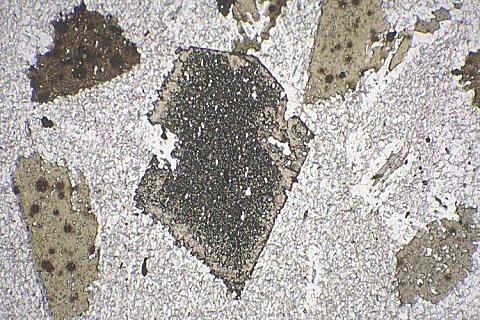
This graphite-free rock shows remarkable detail in the relationships among porphyroblastic minerals. The final assemblage is And + St + Bt + Ms + Pl + Qtz. The fine matrix contains Ms + Qtz + Pl, and the other phases form poikiloblasts. Also present at an earlier stage were chloritoid (which was stable at lower grade with chlorite), and cordierite, which is inferred to be a transient metastable phase. The evidence for these two minerals is preserved in the form of pseudomorphs. Chlorite was a matrix sheet silicate phase and has left no microstructural record.

General view of M32 showing porphyroblastic and poikiloblastic texture of staurolite (centre) and biotite, and quartz-rich pseudomorphs after chloritoid. Plane-polarised light, width of view 3.5 mm.
The microstructure can be understood largely in terms of mineral replacement reactions, with very little grain coarsening or other microstructure-modifying process operating.
Pseudomorphs after chloritoid have rectangular cross-sections. In the matrix they are made of largely of quartz, but within other porphyroblasts they are made entirely of the enclosing mineral (staurolite or andalusite). Element mobility in the intergranular medium does not appear to exert any control on the mechanism.
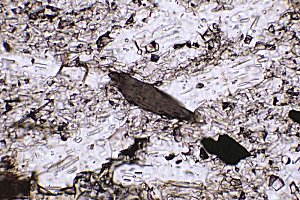
Pseudomorphs after chloritoid, made largely of quartz, with small aligned flakes of muscovite.
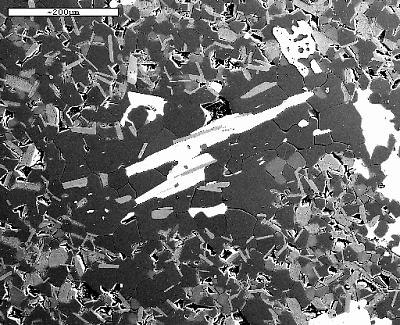
Backscattered electron image of rectangular pseudomorph confirms that the dominant replacing phase is quartz (very dark grey) and that plagioclase (equant grey grains) is confined to the matrix. Scale bar is 0.2 mm.

Part of an andalusite poikiloblast with lath-shaped inclusion-poor domains marking where chloritoid has been replaced by andalusite during porphyroblast growth. Width of view 1.2 mm.
Pseudomorphs after cordierite are harder to see, but commonly have hexagonal outlines. In the matrix they are largely made of quartz (below).
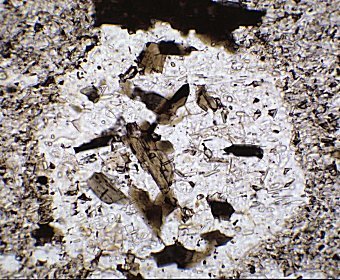
Examine the way poikiloblasts impinge on or enclose each other. The relationships imply very considerable overlap of the growth periods of staurolite, cordierite, biotite and andalusite, coeval with the breakdown of chloritoid.
Staurolite contains
pseudomorphs after chloritoid throughout, but overgrows biotite only towards
its margins (below).
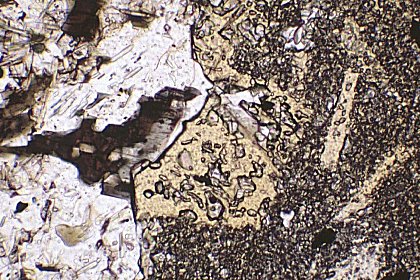
Andalusite has chloritoid pseudomorphs and biotite inclusions throughout. The chloritoid pseudomorphs have uniform size distribution, but biotites are smaller than matrix porphyroblasts.
Staurolite and andalusite
eventually impinge on chloritoid that has already been replaced by quartz.
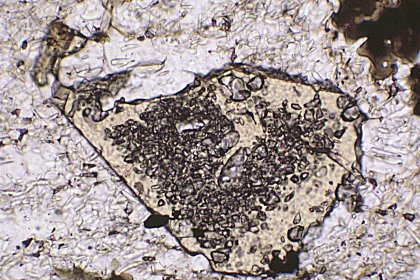
Staurolite has a narrow rim zone with fewer inclusions, except where it is wrapped by andalusite (below). This change in the balance between mineral replacement and accommodation of grain boundaries could be taken to indicate that staurolite was the last phase still growing when the heating rate slowed to zero.
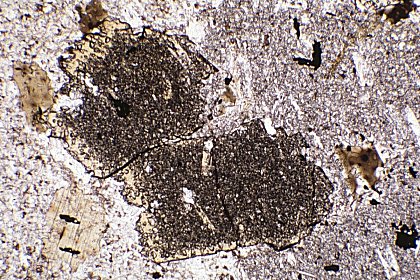
This rock and others like it form the basis of the study by Waters and Lovegrove (2002), in which it is demonstrated that because so many minerals appear to grow over the same general interval, the growth sequence must involve metastable reactions in addition to stable ones.